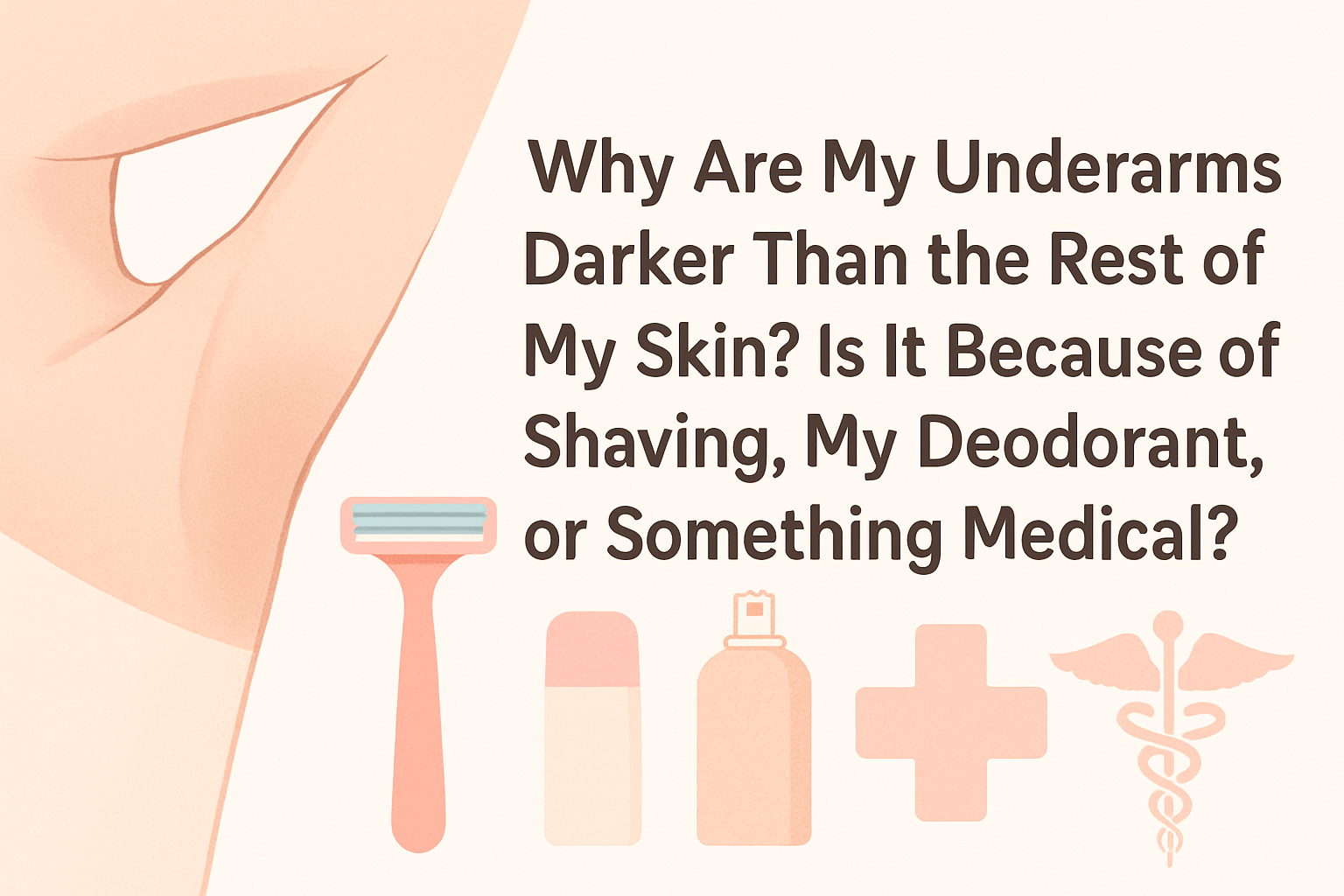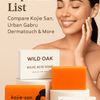My Underarms Became Dark after Pregnancy—Will it Go Away on its Own or do I Need Treatment?

Darker underarms are a concern faced by millions, especially in regions like India where humidity, friction, and daily grooming are frequent parts of life. If you’re constantly wondering, “Why are my underarms noticeably darker than my arms, chest, or neck?”—you’re far from alone.
Underarm darkness can affect confidence, clothing choices, and even signal underlying health issues. This comprehensive guide breaks down all the causes, solutions, and medical insights you need for your skin in 2025.
Understanding Underarm Pigmentation: A Primer
The skin beneath your arms is more delicate and vulnerable than other body parts. It endures frequent shaving or waxing, gets exposed to various chemicals from deodorants, and experiences ongoing friction from clothing. These daily habits, combined with genetics and health factors, make underarm pigmentation a widespread phenomenon.
But what specifically causes these darker patches? Let’s unpack each possibility.
1. Shaving and Hair Removal: Is Your Razor to Blame?
Shaving is one of the top reasons for lastingly dark underarms.
Shadow Effect: Shaving merely slices the hair at skin level, often leaving behind stubble that can show as a shadow on the surface, making underarms look darker right after shaving.
Micro-Injuries and Inflammation: Each swipe of the razor causes tiny cuts and trauma to the skin. The body's healing response increases melanin production, causing post-inflammatory hyperpigmentation.
How Hair Removal Creams and Waxing Compare: Creams can trigger chemical burns in sensitive skin, while waxing aggressively pulls hair from the root, risking irritation and pigmentation. Hot wax burns and repetitive epilation are common culprits in long-term darkening.
Expert Tip:
If you notice darkening after shaving/waxing, consider laser hair removal or gentle epilation. Always moisturize after any form of hair removal, and avoid deodorant with alcohol, aluminum, or harsh fragrances for at least 24–48 hours.
2. Friction and Tight Clothing: The Silent Cause
Your wardrobe may be contributing to your skin troubles more than you realize.
Friction: Repeated rubbing from tight sleeves, synthetic bras, or sportswear can irritate underarms, prompting the skin to thicken and produce extra pigment as protection.
High Sweat and Body Weight: Sweaty underarms are fertile grounds for bacteria and dead skin buildup, especially in humid climates or those with higher body mass, accelerating discoloration.
Active Lifestyles: Athletes and frequent gym-goers are especially at risk—constant movement triggers friction and sweat, leading to dark spots that are often overlooked.
What to Do:
Choose breathable, loose cotton clothing and keep the area dry. Apply gentle, non-irritant creams or sprays to minimize friction and support your skin barrier.

Wild Oak Underarm Brightening Spray + Deodorant
3. The Deodorant and Antiperspirant Dilemma
Deodorant use is almost universal, but not all formulas are skin-friendly.
Harsh Chemicals: Many popular deodorants and antiperspirants contain alcohol (for quick drying), aluminum salts (to block sweat), and synthetic fragrances. These substances can dry out, burn, and inflame sensitive underarm skin, setting the stage for pigment changes.
Contact Dermatitis: Allergic reactions or sensitivities can cause redness, itching, burning, and subsequent darkening.
Build-Up Effect: Years of daily application leave residues in the skin folds, especially if not properly washed off, contributing to long-term pigmentation.
Safer Choices:
Alcohol-free, aluminum-free, and fragrance-free products are much gentler. Look for sprays with soothing and brightening actives, such as niacinamide, mandelic acid, or alpha arbutin—ingredients proven to lighten pigmentation and calm inflammation.
4. Hygiene and Dead Skin Accumulation
Neglecting proper underarm care leads to odor, bacterial overgrowth, and dark, rough patches.
Buildup of Dead Cells: Underarms accumulate sweat, bacteria, deodorant residue, and dead skin—especially without routine exfoliation.
Poor Hygiene: Not cleansing or exfoliating regularly can trap debris in skin folds, stimulating pigment production as the body attempts to protect itself.
Your Routine:
Gently exfoliate once a week using lactic or mandelic acid (never harsh scrubs) and cleanse daily with a mild, unscented wash. Pat dry and moisturize quickly to support healing.
5. Medical Causes: When Is Underarm Darkness a Symptom?
Not all underarm pigmentation is benign. Sometimes, it’s your body signaling a deeper issue.
Acanthosis Nigricans: A condition marked by dark, velvety patches, often found in the underarms, neck, or groin. It can signal insulin resistance, obesity, polycystic ovarian syndrome (PCOS), or thyroid imbalances. Diabetes is a top cause.
Endocrine Disorders: Pregnancy, adolescence, or medical treatments (like oral contraceptives or steroids) trigger hormonal changes that may lead to temporary or permanent skin pigmentation.
Rapid Changes: If your underarm darkness is sudden, asymmetric, itchy, painful, or accompanied by swelling, blisters, or rashes, immediate medical attention is warranted.
Takeaway:
If you suspect hormonal, metabolic, or medication-related causes, consult a dermatologist. They may recommend blood tests or topical treatments to resolve underlying health issues along with pigmentation.
6. Hormonal Shifts: The Pregnancy Connection
Pregnancy frequently causes pigment changes in various body areas, including the underarms.
Why It Happens: Elevated estrogen and progesterone stimulate melanocytes (cells that produce pigment), making sensitive areas darker.
Is It Temporary? Most pigment changes during pregnancy naturally fade over a few months postpartum as hormone levels return to baseline. In some cases, the darkness persists, especially if compounded by friction or harsh products.
Advice for New Moms:
Use gentle skincare and avoid aggressive treatments immediately after pregnancy. If darkness lasts beyond a year or is accompanied by other skin symptoms, seek expert guidance.
Identifying Your Personal Cause
How can you pinpoint the trigger for your dark underarms?
Follow this cheat sheet:
-Recent shaving/waxing + darkness: Inflammation and irritation are likely causes.
-Deodorant triggers rashes or itching: Sensitivity to formula likely; switch to gentle alternatives.
-New fitness routine or tight clothes: Friction-based pigmentation.
-Family history of obesity, diabetes, PCOS: Potential medical cause.
-Pregnancy/postpartum: Probable hormonal pigmentation.
If unsure, patch test products, change routines for a few weeks, and note any skin improvements or worsening.
Best Practices to Prevent and Treat Dark Underarms
A holistic approach is essential—here’s what experts recommend:
A. Choose Gentle Brightening Formulas
Opt for sprays and creams made specifically for sensitive skin. Avoid harsh chemicals and explore products with ingredients like niacinamide (reduces pigment transfer), mandelic acid (mild exfoliation), and alpha arbutin (blocks melanin production).
B. Rethink Hair Removal
Use sharp razors with moisturizing shave gels, or consider long-term options like laser hair removal.
Avoid hot waxing or excessive plucking, and never shave dry skin.
C. Prioritize Barrier Repair
Moisturize daily with fragrance-free, non-comedogenic creams or brightening sprays.
Never apply deodorant or spray to freshly shaved or waxed skin—wait at least 24 hours.
D. Minimize Friction
Wear loose, breathable clothes and switch out bras regularly.
Take breaks on heavy workout days and keep underarms dry.
E. Consult a Dermatologist
For persistent, severe, or painful pigmentation, schedule an appointment.
Review medications and health history to rule out acanthosis nigricans or metabolic disorders.
Home Remedies vs. Clinical Solutions: What Really Works?
Home Remedies:
Lemon juice, potato rubs, baking soda, and honey are popular, but may be too harsh for inflamed or sensitive skin. Lemon can burn, and baking soda may cause dermatitis.
Clinical Solutions:
Topical creams with niacinamide, alpha arbutin, or mild AHAs (lactic/mandelic acid)
Laser therapy for severe pigmentation with underlying conditions
Prescription-strength treatments for acanthosis nigricans or endocrine disorders
Verdict:
Opt for clinically tested, dermatologist-approved solutions if home remedies cause irritation, and focus on gentle, consistent skin care above all.
The Role of Wild Oak Underarm Brightening Spray
Spotlight on Proven Care
For those seeking a safe, science-backed solution for underarm darkness—especially caused by shaving, waxing, friction, or deodorant irritation—Wild Oak Underarm Brightening Spray is a standout choice. Designed for sensitive Indian skin, it is free from alcohol, aluminum, and parabens, with gentle brightening ingredients:

Niacinamide: Calms inflammation, reduces pigment transfer, and supports barrier repair.
Mandelic Acid: Exfoliates dead skin, smoothing texture and fading dark patches.
Alpha Arbutin: Blocks melanin production for lasting brightening without bleaching.
Aloe Vera: Soothes and hydrates post-shave, post-wax, and post-workout skin.

This fast-absorbing spray helps prevent and reverse pigmentation related to hair removal and product irritation, supporting brighter, fresher underarms with daily use.
Frequently Asked Questions
Q: How long does it take to see improvement?
A: With regular use of gentle brightening products (like Wild Oak), visible results often appear within 3–6 weeks. For stubborn darkness, clinical interventions may take several months.
Q: Is shaving the worst method for hair removal?
A: Not always—if done with proper prepping (exfoliation, moisturizing, sharp razor), shaving is safe. Waxing, creams, and epilators all have pros and cons; laser is best for minimal pigmentation risk.
Q: When should I worry about medical causes?
A: Sudden, severe, or spreading darkness—especially with symptoms like itching, pain, or a family history of metabolic disorders—should prompt a doctor visit.
Conclusion: Your Path to Brighter, Healthier Underarms
Underarm darkness is rarely caused by a single factor—it’s a complex interplay of grooming, product choices, clothing, hormones, and sometimes health. The good news? With patience, gentle care, and the right products, you can dramatically improve your skin comfort and appearance.
Review your hair removal routines, switch to kinder products, and prioritize barrier care.
Choose brightening sprays that are alcohol- and aluminum-free, such as Wild Oak, for daily support.
Address friction and hygiene and consult doctors when medical causes are suspected.
Make 2025 the year you say goodbye to underarm darkness and hello to confidence in every outfit. Your skin deserves it!





